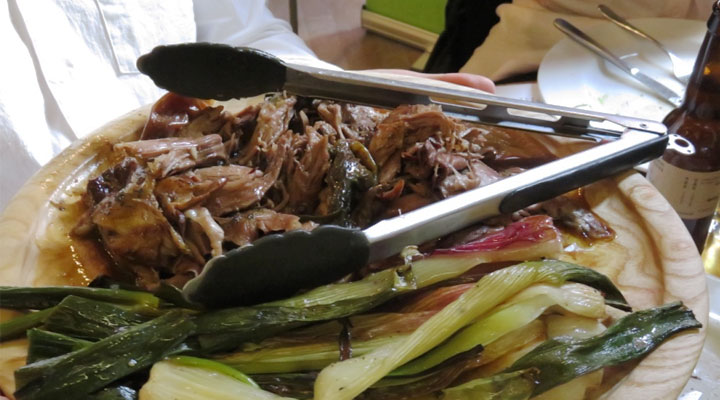Diners praise the different flavours of grass-fed hogget
 The meat from each shoulder was passed around on platters for tasting.
The meat from each shoulder was passed around on platters for tasting.
Diners at Southwark’s Table Café were served four braised shoulders of grass-fed hogget, from four different farms in Cumbria, Kent, the Cotswolds and Monmouthshire, to see if they could taste the difference, one Friday evening in May.
All the farmers, who also attended the evening, are Pasture-for-Life certified, meaning their animals only ever eat grass and never any grain or soya, which most beef animals are fed these days.
As well as being tastier, this means it is healthier for people to eat and has been reared in the most sustainable and animal-friendly way possible.
The shoulders were all prepared for cooking the same way, garlanded with fresh herbs and slowly cooked for six hours. Each piece was presented on platters to the diners, after each farmer had proudly explained a little about his farm and animals.
 Russ Carrington (left) executive secretary of the PFLA, discusses the flavour of the meat from one of the hoggets at the Table Café.
Russ Carrington (left) executive secretary of the PFLA, discusses the flavour of the meat from one of the hoggets at the Table Café.
Different tastes
The words used to describe the meat ranged from ‘soft’ and ‘subtle’ for the Cotswold hogget from Conygree Farm, to ‘earthy’ and ‘rugged’ for the Swaledale hogget, which had lived a harder life on limestone pastures at 1800ft high in Malham, in the Yorkshire Dales.
The Herdwick hogget, which had been grazing pastures managed by the Kent Wildlife Trust, was described as ‘aromatic’ and ‘nutty’, while the Welsh Black from Monmouthshire was thought to be ‘robust’ and taste of ‘liquorice’.
Here is a full list of the descriptive terms used during the night.
| Cotswold | Swaledale | Herdwick from Kent | Black Welsh (2 year old entire ram) |
|---|---|---|---|
| Soft | Earthy | Rich | Liquorice |
| Subtle | Rugged | Browner in colour | Melting |
| Good texture | More texture | More lamby | Buttery |
| Fat different from meat | Working lamb | Herbal | Muttony |
| Mille-feuille | Stoney flavour | Velvety | Gamey |
| Buttery | Darker | Rounded | Dense |
| Caramelly | Gamey | Aromatic | Long length of flavour |
| Flakey | Solid, salt, treacle | Short taste | Tabaco |
| Stratified | Musky | Complex | |
| Nutty | Ballsy | ||
| Smooth | Robust | ||
| Depth | |||
| Fattier |
Privilege to cook and serve
“It was a great privilege to cook and serve these wonderful shoulders of hogget, especially with the farmers who produced them here in the restaurant,” said chef and owner of the Table Café Shaun Alpine Crabtree.
“To be honest I wasn’t sure there would be a difference between the four – but I was wrong. There was so much difference between the raw and cooked shoulders. Each one tasted fantastic – but fantastic in its own way – reflecting very much what it had eaten throughout its life; each had its own ‘terroir’.”
Nick Miller, the farmer who reared the Welsh Black hogget, thanked Shaun for putting on the event and said it was so good to celebrate a sheep’s breed, what it had eaten and its history.
“In my local supermarket the choice for lamb is Welsh or British. But I ask you how many varieties of cheese, or wine or beer, are on sale? Hundreds! Just imagine giving people the choice of just French or Spanish wine!
“I believe this tasting evening is the start of a food movement – one that celebrates tasty, tender and unadulterated meat from 100% grass-fed animals, that shoppers can buy direct from the farm. Find out Where to Buy.”



